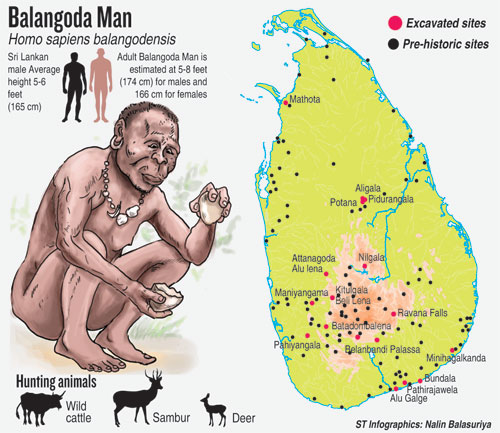News
Prehistoric man stirs to life as scientists find clues to the past in ancient caves
 Our pre-historic humans took refuge in caves that hide many secrets that are helping archaeologists piece together how humans evolved thousands of years ago, the respected archaeologist, Professor Raj Somadeva said.
Our pre-historic humans took refuge in caves that hide many secrets that are helping archaeologists piece together how humans evolved thousands of years ago, the respected archaeologist, Professor Raj Somadeva said.
Recent excavations in a number of caves have produced archaeological finds showing how prehistoric humans, initially living as hunter gatherers, gradually moved to a living based on agriculture.
The changing climate at the end of the last Ice Age about 12,000 years ago triggered this change, and evidence of the missing era between Balangoda Man and written history is gradually being assembled.
Prof. Somadeva made these revelations last week at a news conference organised by the Science and Technology Ministry to brief media about the archaeological research being carried out through a National Science Foundation (NSF) grant.
With this funding, a number of caves inhabited by pre-historic man are being excavated. ‚ÄúWe are having two field work sessions every year, each about one-and-a-half months long during the dry seasons, February-March and August-September. The rest of the year is devoted to analysing the findings and documentation work,‚ÄĚ Prof. Somadeva said.
Research on human evolvement in Sri Lanka was pioneered by Dr. P.E.P Deraniyagala who excavated skeletal remains of anatomically modern Homo sapiens in 1955 from sites near Balangoda. He named this Homo sapiens balangodensis, commonly called Balangoda Man, a being that lived 38,000 years ago. Some 36 skeletons of Balangoda man have now been unearthed from different parts of Sri Lanka together with stone tools.
We have little evidence of the transformation of this man to the modern era. Written history indicates that a population from neighbouring India colonised Sri Lanka, and this is attributed to                        Vijaya’s arrival.
Of course, those who came from India could have brought in a technically advanced culture, but the humans who lived on the island were already an advanced group and it is likely that our pre-historic man’s culture mingled with the introduced culture, Prof.          Somadeva believes.
There is little evidence on the pre-Vijaya era and that is the period the archaeologists are trying to unearth. Prof. Somadeva calls this transition period a ‚Äútwilight period of our history‚ÄĚ.
His team found 35 different half-burned grains from the Lunugala cave they studied. Carbon dating confirmed these to be 6,000 years old. ‚ÄúPerhaps this is clear evidence that our ancestors started experimenting on their own with edible grains,‚ÄĚ Prof. Somadeva said. ‚ÄúToday there are about 64 varieties of edible green leaves available in a village market ‚Äď who found that these were edible? There are lots of plants with medicinal values ‚Äď who found their medicinal¬†¬†¬†¬†¬†¬†¬†¬†¬†¬†¬†¬†¬†¬†¬†¬†¬†¬†¬†¬†¬†¬† effectiveness?‚ÄĚ
He says most of these knowledge came from the experimentation of early home-grown humans.
The archaeologists also found pendants and other non-utilitarian items, and Prof. Somadeva said this is evidence that our early humans showed cognitive ability, knowing the concept of self.
They also found shark teeth in some of the caves. The sea is about 40km from the location of the findings so this indicates our prehistoric man travelled to exchange items from other tribes that lived closer to the sea.
The scientists have also found colourful beads that could have been used for necklaces which have been sent to a laboratory in the United States for carbon dating to determine their age.
The team also found artefacts believed to have been used in rituals, including a sharp stone tool with a bloodstain on one side. Finding bloodstains on such artefacts is extremely rare. Prof. Somadeva said scans by the Medical Research Institute found red blood cells but more was needed for extracting DNA; the team is still hopeful of this.
The archaeologists are also seeking help on the star formations in the skies above Sri Lanka thousands years ago. They have found a piece of rock with holes in it, similar to artefacts found in China and Israel. Chinese archaeologists think their stones indicate stars in Orion‚Äôs Belt, and the Sri Lankan stone could be similar. ‚ÄúDuring the drier period, the stars look bright so this could be something our historic humans used to try to read the sky to predict climate,‚ÄĚ Prof. Somadeva said.
The findings could effectively make a paradigm shift of the history that we know at the end of the project, he predicted.
| Exploring life in the darkness Caves with areas of different light penetrations can be refuge to some of the least studied animals and plants. The scientific study of organisms living in caves is known as biospeleology, and Peradeniya scientists recently studied caves in Nuwara Eliya to explore the life in the darkness. Research by Chathurika Munasinghe of the University of Peradeniya under supervision of Prof. K.B. Ranawana on the Mandaramnuwara and Rotupihilla caves in the wet zone was presented at the Wild Lanka symposium recently organised by the Department of Wildlife Conservation. The researchers walked through these caves exploring different light zones such as the entrance zone, twilight zone and dark zone, recording temperature, humidity and light intensity every Six vertebrate and 12 invertebrate animals were identified in the Mandaramnuwara cave and six vertebrate and 11 invertebrates were identified in the Rotupihilla cave, Ms. Munasinghe said. Bats are common in both these caves with the common wentwing bat and rufous horseshoe bat being the most common. Insects and spiders accustomed to darkness were also found.Also seasonally the edible nests swifts build  in the darkness of these caves. Caves in Sri Lanka are largely unexplored, so the research team suggests conservation measures and education to increase public awareness were important to minimise damage to these cave    |

